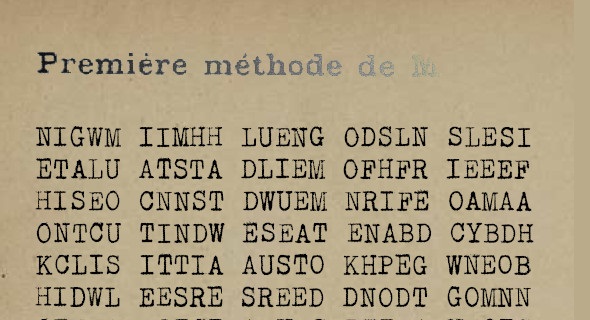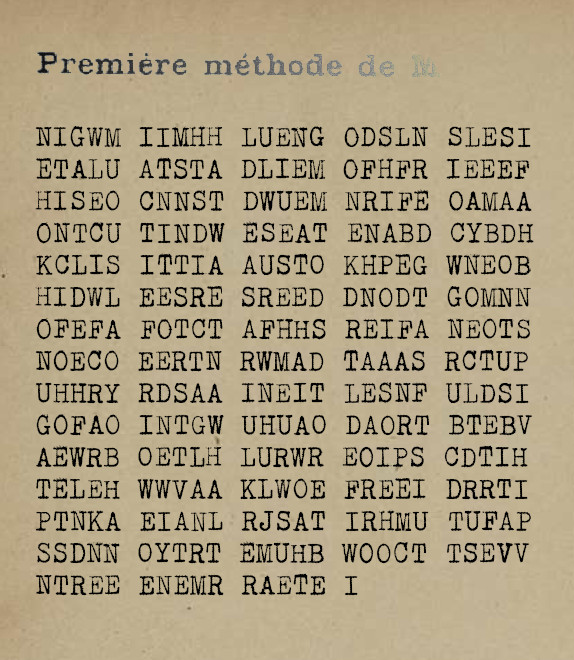Vor drei Monaten hat Norbert Biermann die Challenge von George Lasry gelöst und ist damit der aktuelle Träger des Friedman-Rings. Heute stelle ich Norberts neue Challenge vor. Wer sie löst, wird sein Nachfolger.
English version (translated with DeepL)
Wer das aktuelle Krypto-Rätsel als erstes löst, erstellt das nächste. Nach diesem einfachen Prinzip funktioniert der Friedman-Ring. Dabei handelt es sich um ein Spiel, das nach den Kryptologen William und Elizebeth Friedman benannt ist. Vorbild ist der Iffland-Ring, der bereits seit Jahrhunderten an Schauspieler vergeben wird.
Vor drei Monaten ging die fünfte Runde des Friedman-Ring-Spiels zu Ende. Das bisher letzte Rätsel kam von George Lasry. Norbert Biermann hat es als erster gelöst und wurde damit der neue Träger des Friedman-Rings. Thomas Bosbach hat mit seinen Hinweisen wesentlich zur Lösung des Rätsels beigetragen.
Damit ergibt sich folgende Liste von Trägern:
- Frank Schwellinger
- Anna Salpingidis und Christoph Tenzer
- Armin Krauß
- Christoph Tenzer
- George Lasry
- Norbert Biermann
Es gibt eine Webseite zum bisherigen Verlauf. Der jeweilige Empfänger des Friedman-Rings verpflichtet sich, ein Krypto-Rätsel zu entwickeln und mir zur Verfügung zu stellen. Wer dieses Rätsel als erstes löst, ist der neue Träger.
Bevor es weitergeht, möchte ich noch auf meinen Online-Vortrag am kommenden Sonntag um 18 Uhr (deutsche Zeit) hinweisen. Unter dem nicht ganz ernst gemeinten Titel “How to become a cyber criminal” werde ich einen unterhaltsamen Überblick zum Thema Cybercrime geben. Veranstalter ist wieder die ICCH-Gruppe. Wie immer haben Robert Saltzmann und Tom Perera die Organisation übernommen, wofür ich mich herzlich bedanke. Die Teilnahme ist kostenlos. Der Zugangslink wird über die Cryptocollectors-Mailing-Liste verschickt. Wer diese nicht abonniert hat, kann sich gerne bei mir melden, dann stelle ich den Link zur Verfügung.
Norbert Biermanns Challenge
Kommen wir nun zur neuen Friedman-Ring-Challenge, die Norbert mir zugeschickt hat. Hier ist sie:
Hier ist eine Transkription:
NIGWM IIMHH LUENG ODSLN SLESI ETALU ATSTA DLIEM OFHFR IEEEF HISEO CNNST DWUEM NRIFE OAMAA ONTCU TINDW ESEAT ENABD CYBDH KCLIS ITTIA AUSTO KHPEG WNEOB HIDWL EESRE SREED DNODT GOMNN OFEFA FOTCT AFHHS REIFA NEOTS NOECO EERTN RWMAD TAAAS RCTUP UHHRY RDSAA INEIT LESNF ULDSI GOFAO INTGW UHUAO DAORT BTEBV AEWRB OETLH LURWR EOIPS CDTIH TELEH WWVAA KLWOE FREEI DRRTI PTNKA EIANL RJSAT IRHMU TUFAP SSDNN OYTRT EMUHB WOOCT TSEVV NTREE ENEMR RAETE I
Weitere Informationen hat Norbert bisher nicht zur Verfügung gestellt. Ich bin aber sicher, dass er den einen oder anderen Tipp gibt, wenn meine Leser nicht weiterkommen. Vielen Dank auf jeden Fall an Norbert für diese bestimmt sehr interessante Challenge.
Wie schon öfters erwähnt, gehört es zu den Eigenheiten dieses Spiels, dass jeder Leserhinweis, der als Kommentar veröffentlicht wird, einem anderen Codeknacker zum Gewinn verhelfen kann. Ich bitte meine Leser daher, nicht ganz so egoistisch zu sein. Wenn im Forum über Lösungswege diskutiert wird, macht das die Sache für alle spannender. Natürlich werde ich jeden Kommentar, der zur Lösung beigetragen hat, entsprechend würdigen.
Das Rennen ist eröffnet!
Follow @KlausSchmeh
Further reading: Christoph’s Chaotic Caesar Challenge
Linkedin: https://www.linkedin.com/groups/13501820
Facebook: https://www.facebook.com/groups/763282653806483/




Kommentare (50)